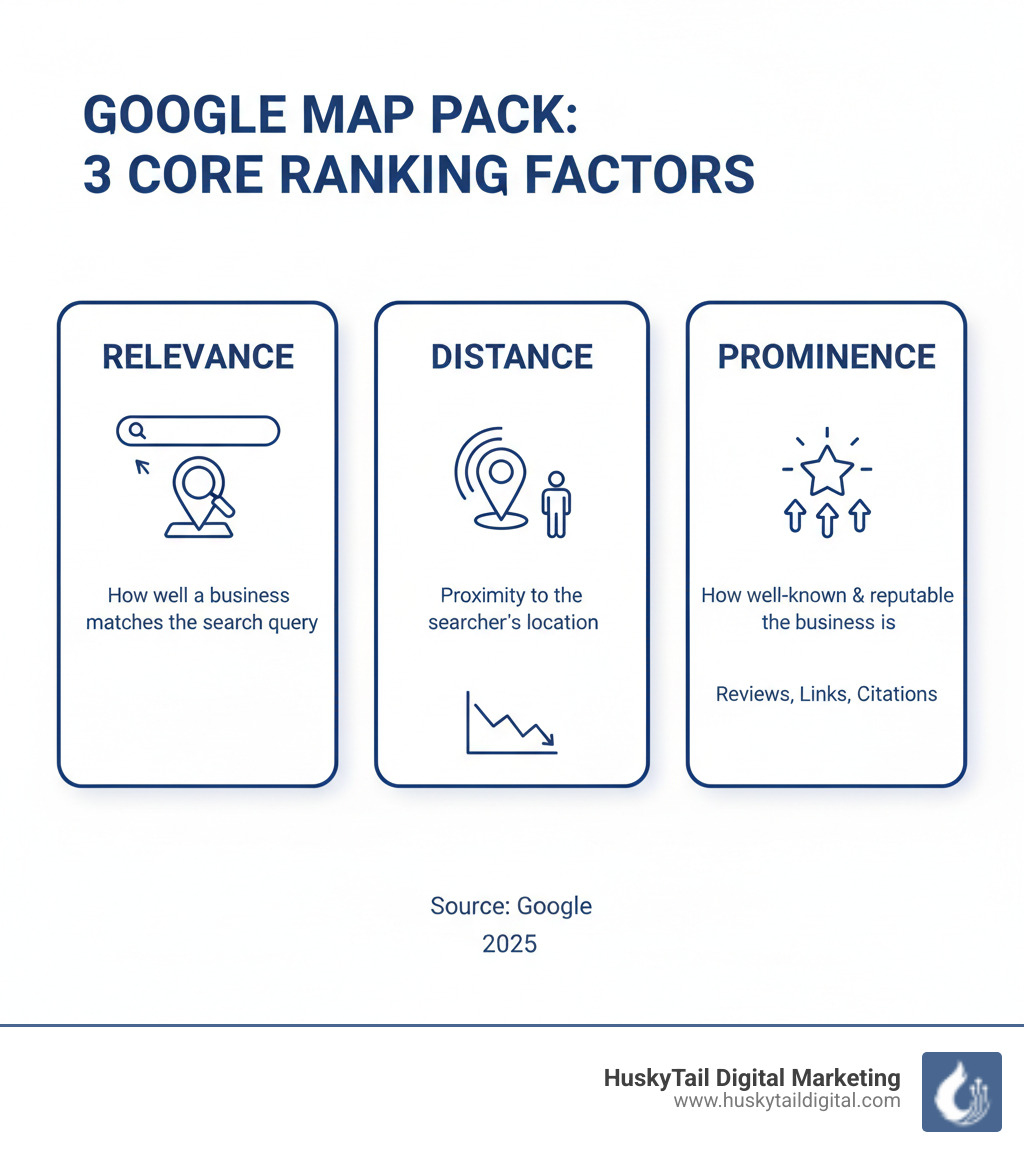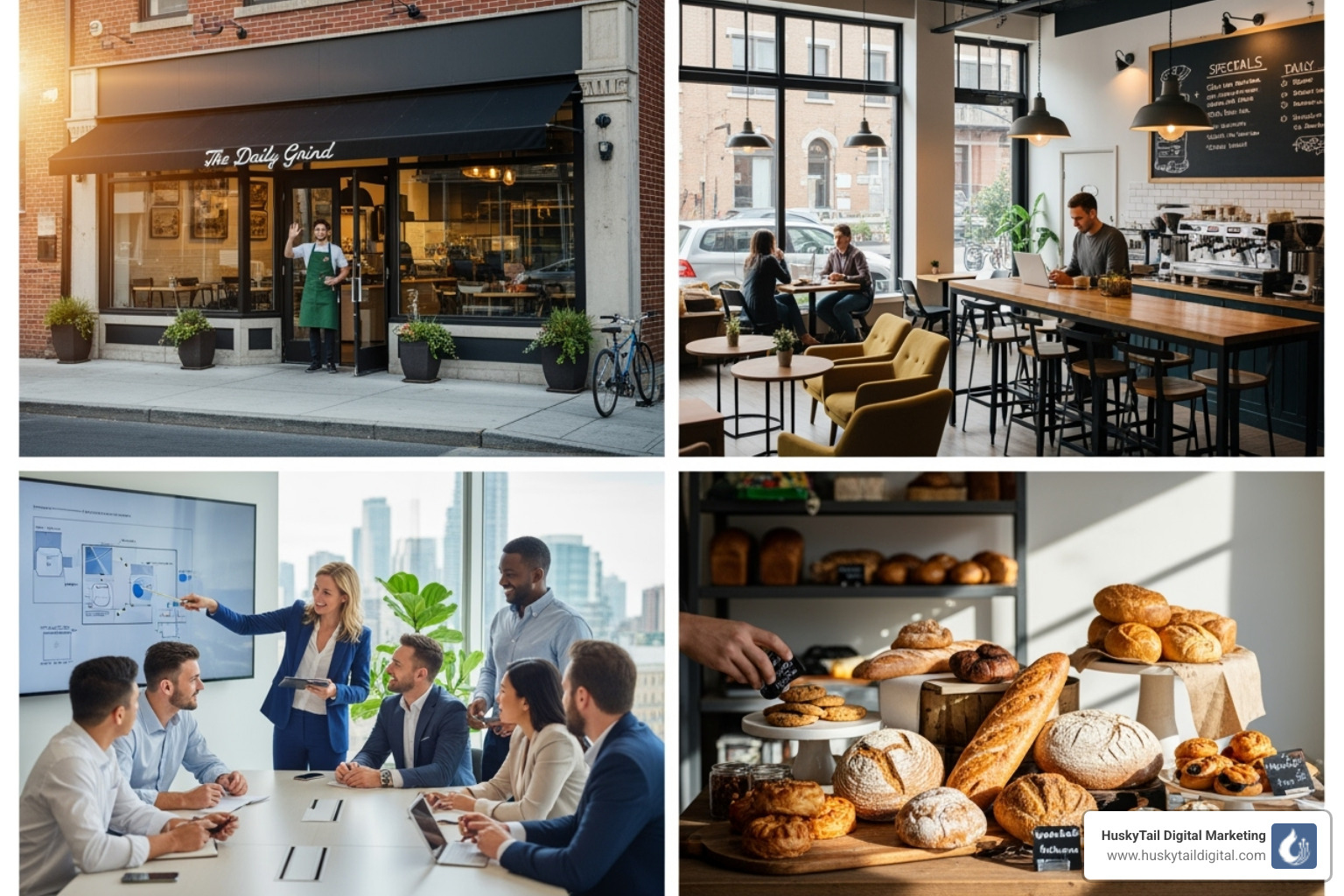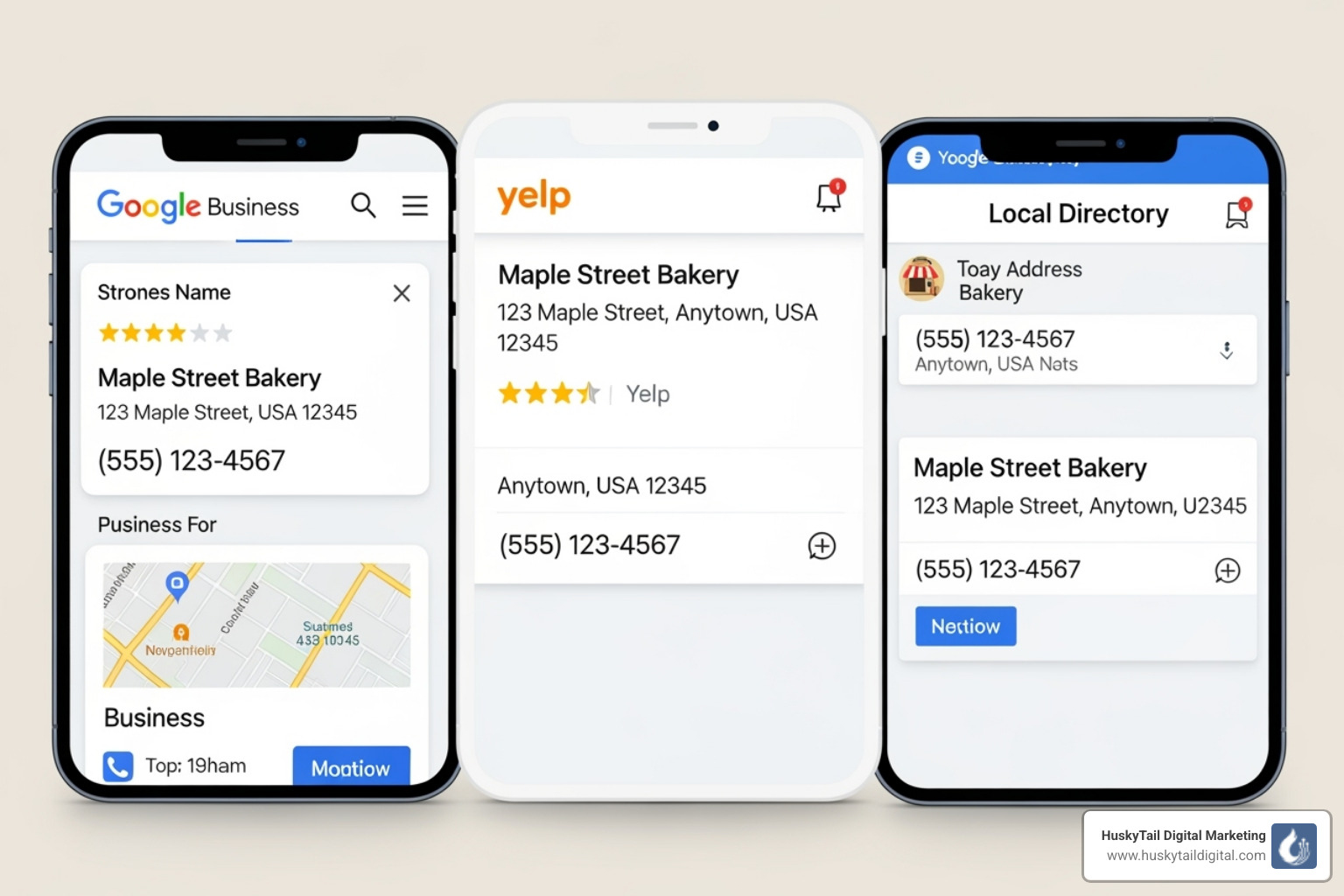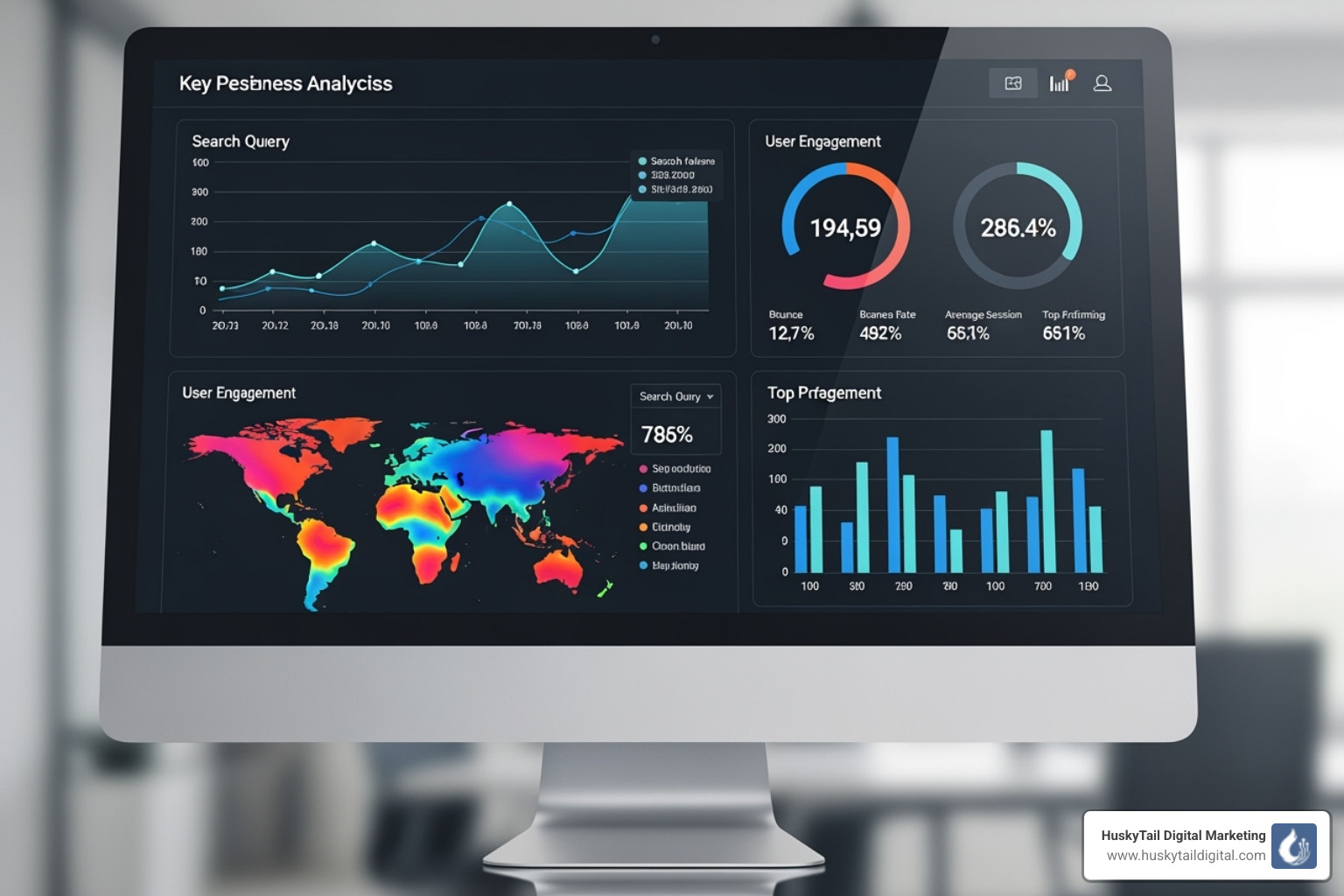Your Business's Digital Front Door
Local map pack optimization is the process of improving your visibility in Google's "Map Pack"—the box with a map and a few business listings that appears at the top of local search results. This involves optimizing your Google Business Profile (GBP), earning positive reviews, ensuring consistent business information online, and optimizing your website for local signals.
When you search for "pizza near me" or "plumber in Chicago," you see the Map Pack. This prime digital real estate is critical for local businesses. Consider that 46% of all Google searches are for local results, and businesses in the pack get 126% more traffic than those below it.
Appearing in the Map Pack puts you in front of high-intent customers who are ready to buy or visit. Google decides who gets this spot based on three core factors: relevance, distance, and prominence.
I'm Stephen Gardner, founder of HuskyTail Digital Marketing. With over two decades of experience, I specialize in local map pack optimization strategies that blend human insight with AI to drive real growth. Understanding these core factors is the first step to dominating local search.

The Three Pillars Of Map Pack Rankings
To rank in Google's Map Pack, your business must excel in three key areas. Understanding these pillars is the foundation of successful local map pack optimization.
Pillar 1: Relevance
Relevance is how well your business matches a search query. Google aims to connect users with the most appropriate local solution.
Your business categories are a primary relevance signal. Choosing the right primary and secondary categories in your Google Business Profile tells Google exactly what you do. According to a report from WhiteSpark, GMB categories are a top-ten ranking factor. As Kristal Taing notes, "Google will reward businesses that have a complete profile."
Service and product listings, along with a well-written business description, add further detail, helping Google match you to specific searches like "drain cleaning." Additionally, signals from your website account for 24% of local organic ranking factors, reinforcing your relevance.
Pillar 2: Distance
Distance is how close your business is to the searcher. For urgent needs, proximity is paramount. Google uses a person's IP address, GPS data, or location-specific searches (e.g., "dentist in Atlanta") to determine their location.
The growth of "near me" searches, which increased by 150% in one year, highlights this trend. People want immediate, nearby solutions.
If you're a Service Area Business (SAB) like a plumber in Local SEO Houston, you can hide your physical address and define your service areas in GBP. This tells Google where you operate. Since 76% of local searches happen on mobile, optimizing for proximity is crucial. For more tips, watch How to improve your local ranking on Google.
Pillar 3: Prominence
Prominence is your business's online reputation and authority. Google wants to recommend well-regarded, trustworthy businesses.
Online reviews are a major factor. The number and quality of your reviews directly influence rankings. A staggering 88% of consumers trust online reviews as much as personal recommendations, and 77% of consumers regularly read them. Furthermore, 89% of people are more likely to choose a business that responds to all its reviews.
Backlinks from reputable sites act as votes of confidence. Our Link Building services focus on earning these valuable links.
Local citations—mentions of your Name, Address, and Phone number (NAP) on directories and social media—help Google verify your business. Consistent NAP is key, as citation signals account for 7% of local pack ranking factors. Even unlinked brand mentions contribute to your online prominence.
Mastering Foundational Local Map Pack Optimization
Now that we understand the pillars, let's cover the actionable steps for local map pack optimization, starting with your Google Business Profile.

Step 1: Claim And Perfect Your Google Business Profile (GBP)
Your GBP is your digital storefront and first impression. If you haven't, go to Google Business Profile to claim and verify your listing. Verification is essential and can be done via phone, email, video, or mail.
A complete profile is critical. As Kristal Taing states, "Google will reward businesses that have a complete profile." Fill out every section accurately:
- Business Name: Use your exact legal name. No keyword stuffing (e.g., use "Joe's Plumbing," not "Joe's Plumbing Best Plumber Phoenix").
- Address & Service Area: Ensure it's precise. For service-area businesses like a plumber in Local SEO Phoenix, hide your address and define your service radius.
- Hours, Phone, Website: Keep hours updated, use a local phone number, and link to your primary website.
- Description & Attributes: Write a compelling description and add specific attributes like "wheelchair accessible" or "women-owned business."
- Services, Products, Photos, & Posts: Detail your offerings, upload high-quality media, and use Google Posts for updates.
A complete profile, like Extra Space Storage's GBP, demonstrates thoroughness and builds trust. Google provides a full guide on profile details here.
Step 2: Choose Strategic Business Categories
Your primary category defines what your business is (e.g., "Bakery"), not what it has (e.g., "Cupcakes"). Add up to nine secondary categories to cover all your services, such as adding "Pharmacy" and "Deli" for a grocery store.
Use tools like GMB Everywhere to see what categories your top competitors use. Ensure your choices accurately reflect your core business.
Step 3: Leverage Photos, Videos, And Posts
Visuals are powerful. Businesses with over 100 images on their GBP get significantly more engagement.

- Photos: Upload high-quality images of your logo, cover, interior, exterior, team, and products.
- Videos: Google encourages videos. Post short, engaging clips (under 30 seconds) that showcase your business.
- Google Posts: Use Posts weekly for offers, events, and updates. A study found 40% of businesses neglect this feature, making it a key opportunity.
Step 4: Engage With Questions & Answers
The Q&A section is a prime opportunity to address customer concerns.
- Proactively add FAQs: Answer common questions yourself, such as "Do you offer free estimates?"
- Respond quickly: Promptly answer customer questions to show excellent service.
- Use keywords naturally: When answering, include relevant terms. For a query about "emergency plumbing" in Local SEO Las Vegas, your answer can reinforce your service and location.
- Demonstrate expertise: Use your answers to build trust and highlight your knowledge.
Advanced Strategies To Boost Your Visibility
With a solid GBP foundation, it's time to build your authority across the web. These advanced strategies expand your reach and shape how Google perceives your business.
Step 1: Build A Powerful Review Portfolio
Reviews are essential for local map pack optimization, impacting both rankings and customer trust. BrightLocal research shows 77% of consumers regularly read Google reviews, and 88% trust them as much as personal recommendations.
- Ask for reviews: Make it easy for satisfied customers to leave feedback with a direct link or QR code.
- Respond to all reviews: Thank customers for positive feedback. For negative reviews, respond professionally, acknowledge the issue, and offer a solution. This shows you care and builds trust with future customers.
- Maintain review velocity: A steady stream of recent reviews signals to Google that your business is active and consistently delivering quality. The number of reviews directly influences rankings.
Step 2: Ensure NAP Consistency With Local Citations
A citation is any online mention of your business's Name, Address, and Phone number (NAP). They appear on directories like Yelp, social media, and other local listings.

Citation signals account for 7% of local pack ranking factors because they help Google verify your business. Consistency is critical. Even minor differences in your NAP across platforms can confuse search engines and dilute your SEO efforts.
Focus on high-quality directories like Yelp and YellowPages, as well as industry-specific sites. Use audit tools like BrightLocal or Whitespark to find and fix inconsistencies.
Step 3: Optimize Your Website For Local Signals
Your website is a core part of your local SEO strategy, with on-page signals accounting for 24% of local organic ranking.
- Localize Content: Incorporate local keywords naturally into your titles, headers, and body content. For businesses serving multiple areas like Local SEO Denver, create unique, location-specific service pages.
- Embed a Google Map: Add an interactive map to your contact page to provide a clear location signal.
- Use LocalBusiness Schema: This structured data helps search engines understand your business details (NAP, hours, etc.) and can help you appear in rich snippets. Our Technical SEO services include implementing this markup.
- Ensure Mobile-Friendliness: With 76% of local searches on mobile, a fast, mobile-friendly site is non-negotiable. Use tools like PageSpeed Insights to ensure your site meets Core Web Vitals standards.
- Build Local Backlinks: Links from local businesses, news sites, or community organizations signal to Google that you're a trusted part of the community. Our Link Building expertise focuses on forging these valuable connections.
Execution, Tracking, And Common Pitfalls
Even the most brilliant strategy means nothing without proper execution and monitoring. Think of local map pack optimization as tending a garden—you need to plant the right seeds, but you also need to water, weed, and watch what grows.
Measuring Your Map Pack Performance
If you're not measuring your results, you're just guessing. Your Google Business Profile Insights dashboard is like a window into your customers' minds. It shows exactly how people find you, what they search for, and what actions they take. We track these numbers religiously because they tell the real story of your Map Pack performance.

We focus on the metrics that matter:
- Keyword Rankings: Track your position for key terms in different locations, like "emergency plumbing Local SEO Charlotte."
- Customer Actions: Monitor calls, website clicks, and direction requests. These are high-intent actions that lead directly to business.
Our reporting dashboards consolidate this data into clear, actionable insights, allowing for continuous refinement of your strategy.
Common Mistakes To Avoid
Avoid these common pitfalls that can sabotage your local SEO efforts:
- Keyword stuffing your business name: This violates Google's guidelines and can lead to suspension. Use your real business name.
- Inconsistent NAP information: Discrepancies across the web confuse Google and hurt your rankings.
- Ignoring negative reviews: Responding professionally shows you care and builds trust with future customers.
- Incorrect service area: Define your service area accurately to attract relevant leads.
- Using a P.O. Box or virtual office: Google requires a real, physical location for most businesses. Service-area businesses can hide their address.
- Neglecting your GBP: A stagnant profile signals inactivity. Keep it fresh with regular posts and photos.
Learn more about these pitfalls in our article, "7 Mistakes You Are Making With Houston Local SEO."
Paid Ads And The Local Pack
Will Google Ads boost your organic Map Pack rank? The short answer is no, not directly.
Google Ads with location extensions can appear in the Map Pack, but they are labeled as an "Ad." These paid placements offer immediate visibility but operate separately from organic rankings. Paying for ads is like renting visibility, while local map pack optimization is like owning it. While paid ads can increase brand awareness, they are not a shortcut to organic Map Pack dominance.
Frequently Asked Questions About Local Map Pack Optimization
Here are answers to common questions about local map pack optimization.
Which Industries Benefit Most From Map Pack Optimization?
If your customers are local, the Map Pack is crucial. It's especially vital for:
- Local service businesses: Plumbers, electricians, roofers (especially in markets like Local SEO Tampa), and landscapers. Up to 70% of searchers in some home services industries use the Map Pack.
- Restaurants and cafes: These businesses thrive on "near me" searches.
- Retail stores: Shoppers check location and hours before visiting.
- Healthcare providers: Dentists, doctors, and chiropractors in areas like Local SEO San Diego rely on local findy.
- Law firms and automotive services: These also depend on connecting with clients in their community.
How Long Does It Take To See Results From Local Map Pack Optimization?
SEO is a marathon, not a sprint. You may see initial improvements within a few weeks, such as more calls or direction requests. However, significant ranking changes for competitive keywords typically take 2 to 6 months of consistent effort.
Local SEO is not a "set it and forget it" task. Google's algorithm, competitors, and customer reviews are always changing, so ongoing optimization is necessary to maintain and improve your position, especially in competitive markets like Local SEO New York.
Can I Rank In A City Where I Don't Have A Physical Address?
This is challenging because the Map Pack prioritizes physical proximity. Ranking in the Map Pack for a city where you lack a physical address is difficult.
However, you can still drive significant traffic by focusing on localized organic search results (the blue links below the map). The strategy involves:
- Creating city-specific landing pages: Develop unique, high-quality content for each target city, like we do for Local SEO Chicago.
- Building local links: Acquire backlinks from businesses and organizations within that target city to signal local relevance to Google.
Your 2025 Blueprint For Local Dominance
As we move through 2025, local map pack optimization is the difference between thriving and being invisible to your customers. With more people searching locally on their phones, appearing in the Map Pack is non-negotiable.
Here's your blueprint for local dominance:
- Perfect Your GBP: Your Google Business Profile must be complete, current, and engaging. Treat it as a living representation of your business.
- Prioritize Reviews: Your reputation is built on reviews. Create a system to encourage feedback and respond to every single review—positive or negative.
- Ensure Consistency: Your business name, address, and phone number (NAP) must be identical everywhere online to build trust with Google.
- Accept Hyperlocal Content: People search with specific local intent (e.g., "plumber in Buckhead"). Create content that speaks directly to these high-intent searchers in markets from Local SEO Atlanta to Local SEO Miami.
Artificial intelligence is also reshaping local SEO. The future of AISEO is here, helping to uncover keyword opportunities and create relevant content at scale. However, AI is a tool, not a replacement for human expertise. The magic happens when you combine AI's power with experienced marketing strategy.
That's our approach at HuskyTail Digital Marketing. We blend AI-driven insights with hands-on expertise to deliver measurable results. Implementing these strategies is a full-time job, and that's where a dedicated partner makes all the difference.
We've helped businesses from Local SEO Orlando to Local SEO Chicago turn their GBP into a customer acquisition machine.
Ready to stop being invisible and start dominating your local search results? Explore our Local SEO services and let's build your roadmap to local dominance together. Your future customers are searching right now—let's make sure they find you first.
-p-1080.webp)


.avif)









.webp)
.avif)
.avif)

